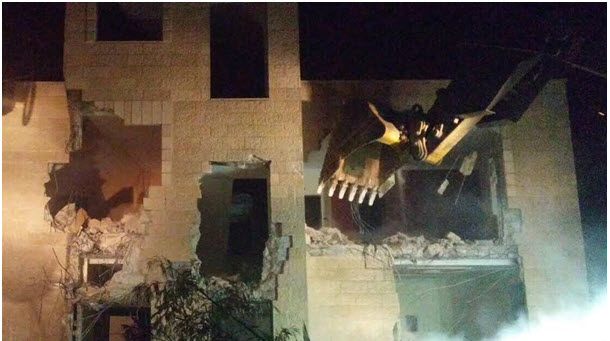Under the escort of armed Israeli forces, bulldozers entered the village of Qalandiya in the northern outskirts of the central occupied West Bank district of Jerusalem late Monday evening, July 25, where they demolished 12 homes, according to locals. Another 8 houses were demolished in Isawya, a Palestinian neighborhood on the eastern ridge of Mount Scopus in occupied East Jerusalem. Israeli authorities destroyed the homes, which had previously been issued demolition notices, claiming they were too close to Israel’s separation wall and that they lacked the proper Israeli-issued licenses.

Secured by armed Israeli forces, a bulldozer destroys one of a 20 Palestinian homes demolished in occupied East Jerusalem on Monday night, July 25. (Photo: IDF)
Clashes erupted between Israeli forces and residents of the Qalandiya who attempted to form a blockade around the 12 homes. Israeli soldiers reportedly fired rubber-coated steel bullets, sponge bullets, tear gas, and stun grenades at locals, and assaulted residents of the homes before the demolitions. According to Ma’an Palestine news agency, among those assaulted during clashes was the head of the Qalandiya village council, Youssef Awadallah, who was taken to a hospital for treatment afterwards. Israeli soldiers reportedly targeted journalists reporting on the demolitions, firing tear gas and stun grenades at them, resulting in the injury of one journalist. Palestinian medical sources told Ma’an that a total of seven Palestinians sustained injuries from rubber-coated steel bullets, tear-gas inhalation, and physical assault.
When the Oslo II Interim Agreement was signed in 1995 between the Palestine Liberation Organization (PLO) and Israel, like many villages across the occupied West Bank, the village of Qalandiya was divided into areas ‘B’ and ‘C’. Approximately 66 dunams, two percent of the total village area, were assigned as Area B, where the Palestinian Authority (PA) officially has complete control over civil matters, but Israel continues to have overriding responsibility for security, according to the Applied Research Institute – Jerusalem (ARIJ). Compared to the small section marked as Area B, approximately 3,207 dunams, roughly 98 percent of the total village area, was classified as Area C, where Israel retains full control over security and civil administration. In Area C, Palestinian building and land management is prohibited unless through a permit given by the Israeli Civil Administration.
Citing the separation wall plan published by the Israeli Defense Ministry in 2007, ARIJ highlighted that with the completed construction of the wall, the urbanized areas of Qalandiya would be isolated from Jerusalem city and neighboring Palestinian communities, and would be surrounded by the wall from all four sides, making the village completely isolated.
According to UN documentation, the Israeli authorities have destroyed some 588 Palestinian structures across the occupied Palestinian territory from January to April. The over 800 Palestinians to be displaced this year far surpasses the number displaced during the entirety of 2015, while well over 1,000 Palestinians were also affected after losing structures related to their source of income. Israel’s home demolition policy has been widely condemned by the international community as collective punishment, executed in direct violation of international law.
The majority of demolitions have taken place in Area C of the West Bank — the more than 60 percent of the West Bank under full Israeli military control.
The Israeli authorities have regularly demolished Palestinian homes in Area C since occupying the West Bank in 1967, but rights groups and Palestinian officials have grown increasingly alarmed by Israel’s renewed demolition campaign this year, accompanied by unprecedented land grabs.


